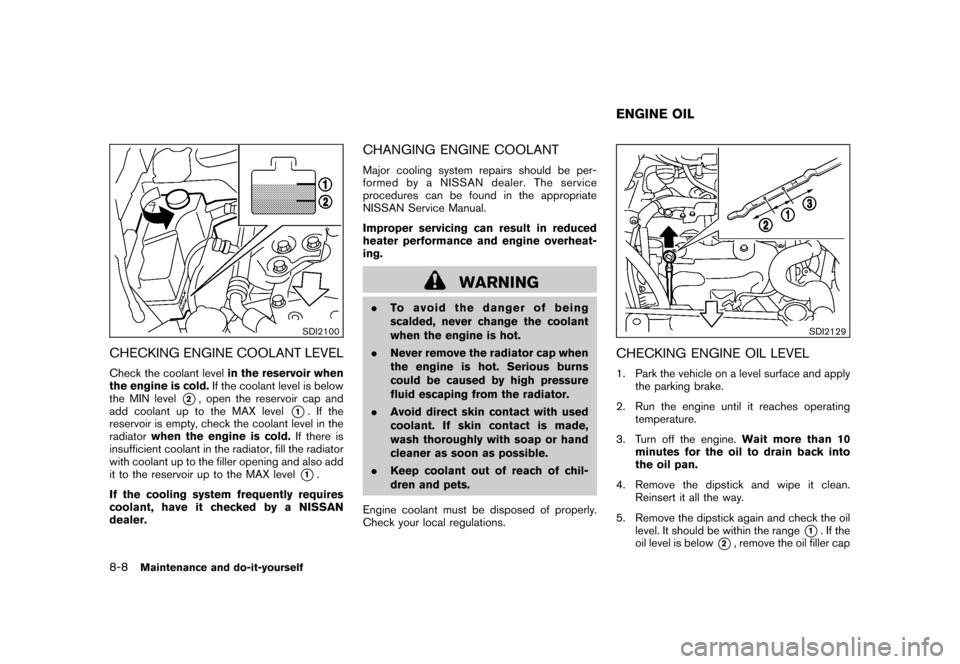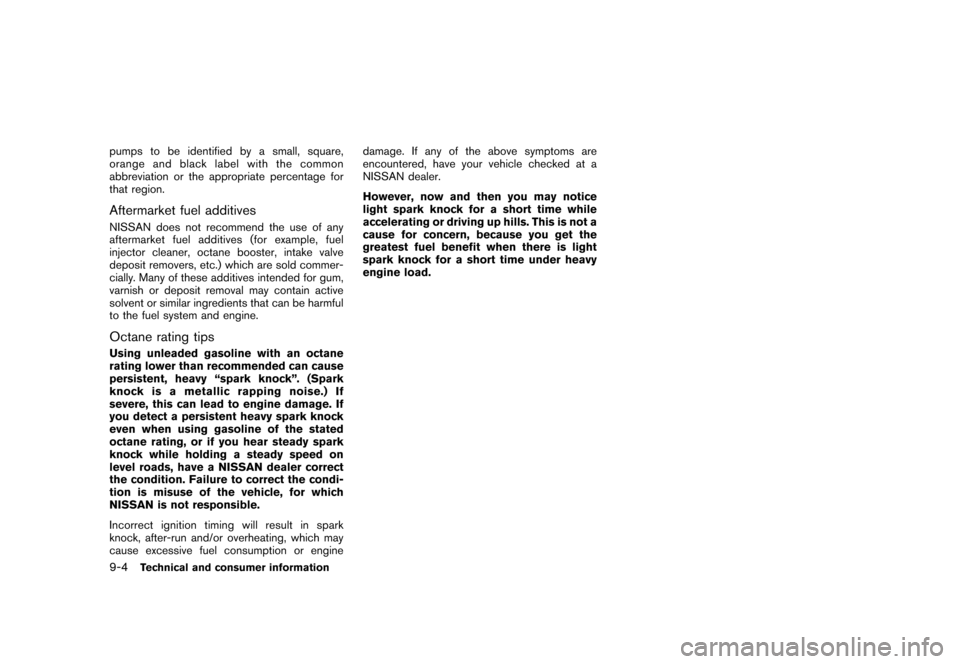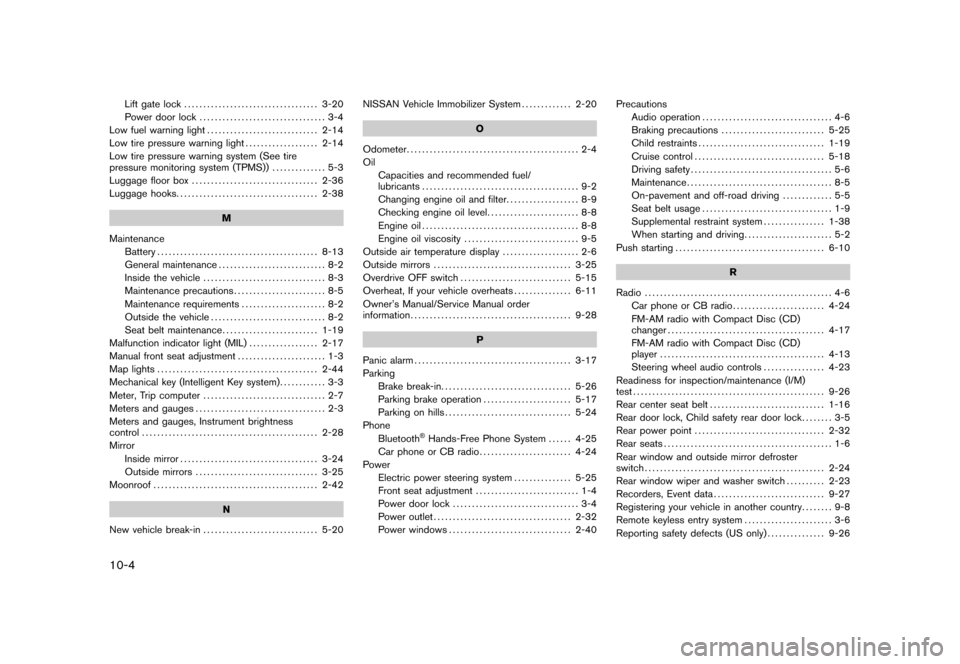2008 NISSAN ROGUE engine overheat
[x] Cancel search: engine overheatPage 239 of 309

Black plate (246,1)
Model "S35-D" EDITED: 2007/ 12/ 19
SDI2100
CHECKING ENGINE COOLANT LEVELCheck the coolant levelin the reservoir when
the engine is cold.If the coolant level is below
the MIN level
*2, open the reservoir cap and
add coolant up to the MAX level
*1. If the
reservoir is empty, check the coolant level in the
radiatorwhen the engine is cold.If there is
insufficient coolant in the radiator, fill the radiator
with coolant up to the filler opening and also add
it to the reservoir up to the MAX level*1.
If the cooling system frequently requires
coolant, have it checked by a NISSAN
dealer.
CHANGING ENGINE COOLANTMajor cooling system repairs should be per-
formed by a NISSAN dealer. The service
procedures can be found in the appropriate
NISSAN Service Manual.
Improper servicing can result in reduced
heater performance and engine overheat-
ing.
WARNING
.To avoid the danger of being
scalded, never change the coolant
when the engine is hot.
.Never remove the radiator cap when
the engine is hot. Serious burns
could be caused by high pressure
fluid escaping from the radiator.
.Avoid direct skin contact with used
coolant. If skin contact is made,
wash thoroughly with soap or hand
cleaner as soon as possible.
.Keep coolant out of reach of chil-
dren and pets.
Engine coolant must be disposed of properly.
Check your local regulations.
SDI2129
CHECKING ENGINE OIL LEVEL1. Park the vehicle on a level surface and apply
the parking brake.
2. Run the engine until it reaches operating
temperature.
3. Turn off the engine.Wait more than 10
minutes for the oil to drain back into
the oil pan.
4. Remove the dipstick and wipe it clean.
Reinsert it all the way.
5. Remove the dipstick again and check the oil
level. It should be within the range
*1. If the
oil level is below
*2, remove the oil filler cap
ENGINE OIL
8-8
Maintenance and do-it-yourself
Page 275 of 309

Black plate (284,1)
Model "S35-D" EDITED: 2007/ 12/ 19
pumps to be identified by a small, square,
orange and black label with the common
abbreviation or the appropriate percentage for
that region.Aftermarket fuel additivesNISSAN does not recommend the use of any
aftermarket fuel additives (for example, fuel
injector cleaner, octane booster, intake valve
deposit removers, etc.) which are sold commer-
cially. Many of these additives intended for gum,
varnish or deposit removal may contain active
solvent or similar ingredients that can be harmful
to the fuel system and engine.Octane rating tipsUsing unleaded gasoline with an octane
rating lower than recommended can cause
persistent, heavy “spark knock”. (Spark
knock is a metallic rapping noise.) If
severe, this can lead to engine damage. If
you detect a persistent heavy spark knock
even when using gasoline of the stated
octane rating, or if you hear steady spark
knock while holding a steady speed on
level roads, have a NISSAN dealer correct
the condition. Failure to correct the condi-
tion is misuse of the vehicle, for which
NISSAN is not responsible.
Incorrect ignition timing will result in spark
knock, after-run and/or overheating, which may
cause excessive fuel consumption or enginedamage. If any of the above symptoms are
encountered, have your vehicle checked at a
NISSAN dealer.
However, now and then you may notice
light spark knock for a short time while
accelerating or driving up hills. This is not a
cause for concern, because you get the
greatest fuel benefit when there is light
spark knock for a short time under heavy
engine load.9-4
Technical and consumer information
Page 288 of 309

Black plate (297,1)
Model "S35-D" EDITED: 2007/ 12/ 19
for proper towing.MAXIMUM LOAD LIMITS
Maximum trailer loadsNever allow the total trailer load to exceed the
value specified in the “Towing Load/Specifica-
tion” chart. The total trailer load equals trailer
weight plus its cargo weight.
.When towing a trailer load of 1,000 lbs
(454 kg) or more, trailers with a brake
system MUST be used.
The maximum GCWR (Gross Combined Weight
Rating) should not exceed the value specified in
the following “Towing Load/Specification” chart.
STI0541
The GCWR equals the combined weight of the
towing vehicle (including passengers and cargo)
plus the total trailer load. Towing loads greater
than these or using improper towing equipment
could adversely affect vehicle handling, braking
and performance.
The ability of your vehicle to tow a trailer is not
only related to the maximum trailer loads, but
also the places you plan to tow. Tow weights
appropriate for level highway driving may have to
be reduced on very steep grades or for low
traction situations (for example, on slippery boat
ramps) .
Temperature conditions can also affect towing.
For example, towing a heavy trailer in highoutside temperatures on graded roads can
affect engine performance and cause overheat-
ing. The transmission high fluid temperature
protection mode, which helps reduce the
chance of transmission damage, could activate
and automatically decrease engine power.
Vehicle speed may decrease under high load.
Plan your trip carefully to account for trailer and
vehicle load, weather and road conditions.
WARNING
Overheating can result in reduced en-
gine power and vehicle speed. The
reduced speed may be lower than other
traffic, which could increase the chance
of a collision. Be especially careful
when driving. Pull to the side of the
road to a safe area. Allow the engine to
cool and return to normal operation.
See “IF YOUR VEHICLE OVERHEATS”
in the “6. In case of emergency” section
of this manual.
CAUTION
Vehicle damage resulting from impro-
per towing procedures are not covered
by NISSAN warranties.Technical and consumer information
9-17
Page 294 of 309

Black plate (303,1)
Model "S35-D" EDITED: 2007/ 12/ 19
3. Shift the transmission into gear.
4. Release the parking brake.
5. Drive slowly until the vehicle and trailer are
clear from the blocks.
6. Apply and hold the brake pedal.
7. Have someone retrieve and store the blocks.
.When going down a hill, shift into a lower
gear and use the engine braking effect.
When going up a long grade, downshift the
transmission to a lower gear and reduce
speed to reduce chances of engine over-
loading and/or overheating.
.If the engine coolant rises to an extremely
high temperature when the air conditioning
system is on, turn off the air conditioner.
Coolant heat can be additionally vented by
opening the windows, switching the fan
control to high and setting the temperature
control to the HOT position.
.Trailer towing requires more fuel than normal
circumstances.
.Avoid towing a trailer for the first 500 miles
(800 km) .
.Have your vehicle serviced more often than
at intervals specified in the recommended
maintenance schedule in the NISSAN Ser-
vice and Maintenance Guide..When making a turn, your trailer wheels will
be closer to the inside of the turn than your
vehicle wheels. To compensate for this,
make a larger than normal turning radius
during the turn.
.Crosswinds and rough roads will adversely
affect vehicle/trailer handling, possibly caus-
ing vehicle sway. When being passed by
larger vehicles, be prepared for possible
changes in crosswinds that could affect
vehicle handling. If swaying does occur,
firmly grip the steering wheel, steer straight
ahead, and immediately (but gradually)
reduce vehicle speed. This combination will
help stabilize the vehicle. Never increase
speed.
Do the following if the trailer begins to sway:
1. Take your foot off the accelerator pedal to
allow the vehicle to coast and steer as
straight ahead as the road conditions allow.
This combination will help stabilize the
vehicle.
— Do not correct trailer sway by steering or
applying the brakes.
2. When the trailer sway stops, gently apply
the brakes and pull to the side of the road in
a safe area.
3. Try to rearrange the trailer load so it is
balanced as described earlier in this section..Be careful when passing other vehicles.
Passing while towing a trailer requires
considerably more distance than normal
passing. Remember the length of the trailer
must also pass the other vehicle before you
can safely change lanes.
.Down shift the transmission to a lower gear
for engine braking when driving down steep
or long hills. This will help slow the vehicle
without applying the brakes.
.Avoid holding the brake pedal down too
long or too frequently. This could cause the
brakes to overheat, resulting in reduced
braking efficiency.
.Increase your following distance to allow for
greater stopping distances while towing a
trailer. Anticipate stops and brake gradually.
.Do not use cruise control while towing a
trailer.
.Some states or provinces have specific
regulations and speed limits for vehicles
that are towing trailers. Obey the local
speed limits.
.Check your hitch, trailer wiring harness
connections, and trailer wheel lug nuts after
50 miles (80 km) of travel and at every
break.
.When stopped in traffic for long periods of
Technical and consumer information
9-23
Page 303 of 309

Black plate (2,1)
10-2Continuously Variable Transmission (CVT)
fluid................................................. 8-11
Controls, Steering wheel audio controls......... 4-23
Coolant
Capacities and recommended fuel/
lubricants......................................... 9-2
Changing engine coolant........................ 8-8
Checking engine coolant level.................. 8-8
Corrosion protection................................. 7-5
Cover, Cargo cover................................ 2-37
Cruise control...................................... 5-18
Cup holders........................................ 2-33
CVT, Driving with CVT (Continuously Variable
Transmission)....................................... 5-12
D
Daytime running light system..................... 2-27
Defroster switch, Rear window and outside
mirror defroster switch............................ 2-24
Dimensions and weights............................ 9-8
Door open warning light........................... 2-13
Drive belts.......................................... 8-14
Driving
All-wheel drive (AWD)......................... 5-21
Cold weather driving.......................... 5-29
Driving with CVT (Continuously Variable
Transmission)................................... 5-12
On-pavement and off-road driving............. 5-5
Precautions when starting and driving......... 5-2
Safety precautions............................... 5-6
E
Economy, Fuel ..................................... 5-20
Elapsed time ......................................... 2-8Electric power steering system................... 5-25
Electric power steering warning light............ 2-13
Emission control information label................ 9-10
Emission control system warranty................ 9-26
Engine
Before starting the engine.................... 5-11
Break-in schedule.............................. 5-20
Capacities and recommended fuel/
lubricants......................................... 9-2
Changing engine coolant........................ 8-8
Changing engine oil and filter................... 8-9
Checking engine coolant level.................. 8-8
Checking engine oil level........................ 8-8
Coolant temperature gauge..................... 2-5
Engine block heater........................... 5-30
Engine compartment check locations.......... 8-6
Engine cooling system.......................... 8-7
Engine oil......................................... 8-8
Engine oil and oil filter recommendation....... 9-5
Engine oil viscosity.............................. 9-5
Engine serial number............................ 9-9
Engine specifications............................ 9-7
If your vehicle overheats....................... 6-11
Starting the engine............................ 5-11
Event data recorders (EDR)....................... 9-27
Exhaust gas (Carbon monoxide).................... 5-2
F
F.M.V.S.S./C.M.V.S.S. certification label............ 9-9
Filter
Air cleaner housing filter...................... 8-16
Changing engine oil and filter................... 8-9
Flashers (See hazard warning flasher switch) . . . 2-29
Flat tire................................................ 6-2Flat towing.......................................... 9-24
Floor mat cleaning................................... 7-4
Fluid
Brake fluid...................................... 8-11
Capacities and recommended fuel/
lubricants......................................... 9-2
Continuously Variable Transmission (CVT)
fluid............................................. 8-11
Engine coolant ................................... 8-7
Engine oil......................................... 8-8
Window washer fluid .......................... 8-12
FM-AM radio with Compact Disc (CD)
player.............................................. 4-13
FM-AM-SAT radio with Compact Disc (CD)
changer............................................. 4-17
Fog light switch.................................... 2-29
Front manual seat adjustment....................... 1-3
Front passenger air bag and status light........ 1-45
Front power seat adjustment....................... 1-4
Front seat adjustment............................... 1-3
Front-seat active head restraints................... 1-8
Fuel
Capacities and recommended fuel/
lubricants......................................... 9-2
Distance to empty............................... 2-7
Fuel economy.................................. 5-20
Fuel octane rating................................ 9-3
Fuel recommendation............................ 9-3
Fuel-filler cap................................... 3-21
Fuel-filler door.................................. 3-21
Gauge ............................................ 2-6
Fuses............................................... 8-19
Fusible links........................................ 8-19
Model "S35-D" EDITED: 2007/ 12/ 25
Page 305 of 309

Black plate (4,1)
10-4
Lift gate lock................................... 3-20
Power door lock................................. 3-4
Low fuel warning light............................. 2-14
Low tire pressure warning light................... 2-14
Low tire pressure warning system (See tire
pressure monitoring system (TPMS)).............. 5-3
Luggage floor box................................. 2-36
Luggage hooks..................................... 2-38
M
Maintenance
Battery.......................................... 8-13
General maintenance............................ 8-2
Inside the vehicle................................ 8-3
Maintenance precautions........................ 8-5
Maintenance requirements...................... 8-2
Outside the vehicle.............................. 8-2
Seat belt maintenance......................... 1-19
Malfunction indicator light (MIL).................. 2-17
Manual front seat adjustment....................... 1-3
Map lights .......................................... 2-44
Mechanical key (Intelligent Key system)............ 3-3
Meter, Trip computer................................ 2-7
Meters and gauges.................................. 2-3
Meters and gauges, Instrument brightness
control.............................................. 2-28
Mirror
Inside mirror.................................... 3-24
Outside mirrors................................ 3-25
Moonroof........................................... 2-42
N
New vehicle break-in.............................. 5-20NISSAN Vehicle Immobilizer System............. 2-20
O
Odometer............................................. 2-4
Oil
Capacities and recommended fuel/
lubricants......................................... 9-2
Changing engine oil and filter................... 8-9
Checking engine oil level........................ 8-8
Engine oil......................................... 8-8
Engine oil viscosity.............................. 9-5
Outside air temperature display.................... 2-6
Outside mirrors.................................... 3-25
Overdrive OFF switch............................. 5-15
Overheat, If your vehicle overheats............... 6-11
Owner’s Manual/Service Manual order
information.......................................... 9-28
P
Panic alarm......................................... 3-17
Parking
Brake break-in.................................. 5-26
Parking brake operation....................... 5-17
Parking on hills................................. 5-24
Phone
Bluetooth
®Hands-Free Phone System...... 4-25
Car phone or CB radio........................ 4-24
Power
Electric power steering system............... 5-25
Front seat adjustment........................... 1-4
Power door lock ................................. 3-4
Power outlet.................................... 2-32
Power windows................................ 2-40Precautions
Audio operation.................................. 4-6
Braking precautions........................... 5-25
Child restraints................................. 1-19
Cruise control.................................. 5-18
Driving safety..................................... 5-6
Maintenance...................................... 8-5
On-pavement and off-road driving............. 5-5
Seat belt usage .................................. 1-9
Supplemental restraint system................ 1-38
When starting and driving....................... 5-2
Push starting....................................... 6-10
R
Radio................................................. 4-6
Car phone or CB radio........................ 4-24
FM-AM radio with Compact Disc (CD)
changer......................................... 4-17
FM-AM radio with Compact Disc (CD)
player........................................... 4-13
Steering wheel audio controls ................ 4-23
Readiness for inspection/maintenance (I/M)
test.................................................. 9-26
Rear center seat belt .............................. 1-16
Rear door lock, Child safety rear door lock........ 3-5
Rear power point .................................. 2-32
Rear seats............................................ 1-6
Rear window and outside mirror defroster
switch............................................... 2-24
Rear window wiper and washer switch.......... 2-23
Recorders, Event data............................. 9-27
Registering your vehicle in another country........ 9-8
Remote keyless entry system....................... 3-6
Reporting safety defects (US only)............... 9-26
Model "S35-D" EDITED: 2007/ 12/ 25